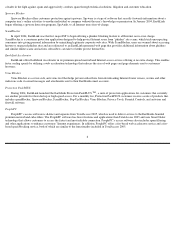Earthlink 2004 Annual Report Download - page 15
Download and view the complete annual report
Please find page 15 of the 2004 Earthlink annual report below. You can navigate through the pages in the report by either clicking on the pages listed below, or by using the keyword search tool below to find specific information within the annual report.
We may not be able to successfully implement our broadband strategy, which could adversely affect our ability to grow or sustain revenues
and our profitability.
As of December 31, 2004, subscribers for our broadband, or high-speed, services comprised approximately 25% of our total customer
base, and our broadband services have favorably contributed to our overall average monthly service revenue per subscriber. One component of
our strategy for increasing our broadband customer base and revenues is to ensure we can cost-effectively purchase wholesale broadband
access. We continue to experience resistance from the regional bell operating companies (“RBOCs”) and cable providers in gaining cost-
effective, wholesale access to their networks over which we could provide our high-speed access services. We have agreements with many of
the RBOCs for wholesale access; however, we continue to observe competitive retail pricing by the RBOCs for high-speed access without
corresponding declines in the prices for wholesale access, which inhibits our ability to compete on a cost-effective basis. Cable providers have
generally resisted granting us wholesale access to their networks to provide high-
speed access services and have generally not been required by
law to make access available. We continue to evaluate the commercial feasibility of emerging alternative broadband technologies, including
power line and fixed wireless, to gain further wholesale broadband access and create greater wholesale broadband access competition. Our
results of operations could be adversely affected if we are unable to maintain or expand our broadband footprint or are unable to obtain
wholesale prices that allow us to cost effectively sell our high-speed services.
Competition for broadband services continues to increase. Competitors have used and may continue to use aggressive marketing efforts,
including significantly discounting the retail price of their services, to attract new subscribers which may adversely impact the number of
broadband customers we are able to add. There can be no assurance that we will be able to continue to attract subscribers to these services, that
we will not experience increased churn with respect to these services or that we will not reduce the profitability of our broadband services to
remain competitive, any of which could adversely affect our broadband subscriber base and revenues.
A significant component of our broadband strategy is managing and reducing the costs associated with delivering broadband services,
including recurring service costs such as telecommunications and customer support costs as well as costs incurred to add new broadband
customers such as sales and marketing and installation and hardware costs. While we believe cost reductions associated with the delivery of
broadband access services will result in broadband contributing positively to overall operating profit margins, our profitability would be
adversely affected if we are unable to continue to manage and reduce recurring service costs associated with the delivery of broadband services
and costs incurred to add new broadband customers.
We may not successfully enhance existing or develop new products and services in a cost-effective manner to meet customer demand in the
rapidly evolving market for Internet, wireless and wireline communications services .
The market for Internet and telecommunications services is characterized by rapidly changing technology, evolving industry standards,
changes in customer needs and frequent new service and product introductions. We are currently focused on developing and evaluating
technologies and applications associated with wireless and wireline voice services, including VoIP services; developing applications to enhance
customers’
Internet experiences; and researching and testing technologies used to deliver broadband services, among others. Our future success
will depend, in part, on our ability to use leading technologies effectively, to continue to develop our technical expertise, to enhance our
existing services and to develop new services that meet changing customer needs on a timely and cost-effective basis. We may not be able to
adapt quickly enough to changing technology, customer requirements and industry standards. If we fail to use new technologies effectively, to
develop our technical expertise and new services or to enhance existing services on a timely basis, either internally or through arrangements
with third parties, our product and service offerings may fail to meet customer needs which would adversely affect our revenues.
12
























